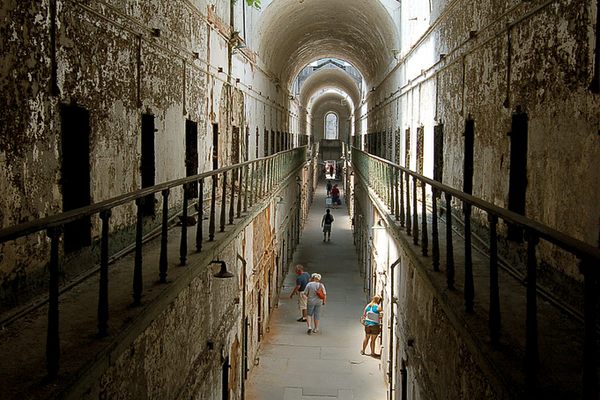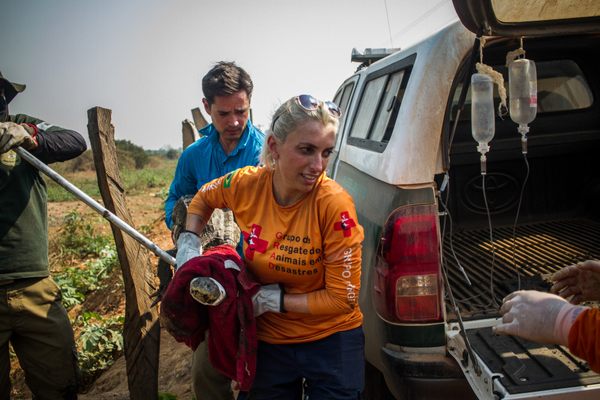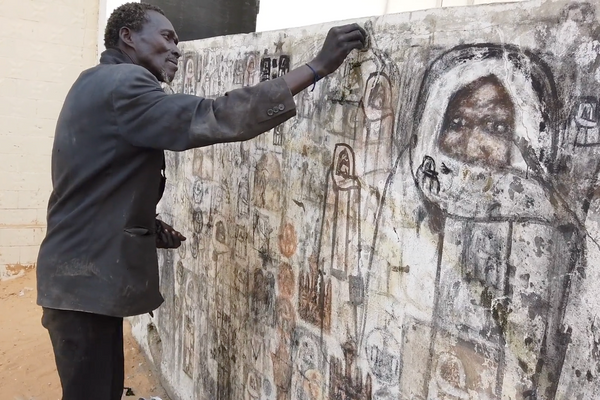
The End of Centralia’s Abandoned, Colorful, Anarchic ‘Graffiti Highway’
First the fractured stretch of road became a canvas, then a gathering place. Now it will become forest.
A trio of camera-toting 20-somethings stumble out of a Delaware-plated Honda Civic onto the shoulder of a rural Pennsylvania highway. It’s summer 2020, and amid the pandemic, they’ve road-tripped nearly three hours up circuitous, mountain roads to reach their off-the-grid destination: the notorious, smoldering, coal-country ghost town of Centralia. They’ve come to this remote corner of Columbia County to take in one sight in particular, the vast spray-painted surface a mile of the former Route 61, commonly known as “Graffiti Highway.”
But, to their surprise, the promised anarchic, visual feast just beyond the “No Trespassing” signs is gone. As of early April 2020, the colorful art, scrawled wisdom, and periodic vulgarity of the highway was officially laid to rest by the property’s current owners, Pagnotti Enterprises, on the grounds that one person’s postapocalyptic wonderland is another entity’s liability. The road’s messages—from “You fell in love with my flower but not my roots,” to “Out of nothing came everything,” to “OBEY … if you want to”—now rest beneath pyramids of dirt.
Formally closed in 1993 due to a decades-long mine fire simmering beneath its surface, this abandoned 0.74-mile stretch of road had achieved cult status in the first decade of the 2000s. After years of disuse, it took on new life as an artistic commons adorned with everything from pineapple-carapaced turtles to less-than-family-friendly fare, often of the male anatomical variety. By 2017, it was anecdotally cited by some locals as the sixth-most-visited attraction in the state. Its warped surface was a magnet not just for taggers, but also for horror fans and gamers in search of one of the inspirations behind Silent Hill (the 2006 movie based on the video game), mountain bikers, skaters, ATV enthusiasts, photographers, local party people, ghost hunters, and the generally curious.

The story of the Graffiti Highway is—in the words of playwright and Kutztown University professor Deryl Johnson—really an “epilogue” to the story of Centralia itself. A mid-19th century boomtown built on the promise of subterranean mineral riches, Centralia boasted 14 mines and a population of 2,500 by 1890. Mining of the carbon-dense anthracite buried 2,000 to 3,000 feet beneath the surface peaked in 1917, only to decline in the 1920s as heating oil replaced hard coal. Despite a resurgence during World War II, demand again plummeted. By the 1950s, the industry had collapsed. Centralia’s labyrinthine underground mine networks were increasingly abandoned.
As historian Joan Quigley explains in The Day the Earth Caved In: An American Mining Tragedy, the loss of tax revenue from the exodus of the region’s keystone industry impacted municipal operations, including the operation of landfills. Cash-strapped towns like Centralia used stripping pits— “hollowed-out caverns where bulldozers and high-powered steam shovels had once pawed into the earth for anthracite,” in Quigley’s words—for garbage disposal. It was in one of these abandoned pits that Centralia’s inextinguishable fire ignited in May 1962. Just before Memorial Day, a routine, controlled burn of trash set by the local fire department migrated from the pit into the unused underground warrens. Throughout the 1960s and 1970s, residents of the borough witnessed failed efforts to quell the underground blaze, from fly ash barriers and to actually digging it out. Everything fell short.
A living, moving entity, the conflagration spread as wooden mine scaffolding burned away and created gaps for oxygen to fuel the burning coal. By the late 1970s, the fire had migrated from the dump site into residential areas. Noxious fumes increasingly invaded homes. Centralians listened for the warning wail of carbon monoxide detectors, and actually kept pet canaries to foretell potentially life-threatening gases. They watched smoke creep from cracks and fissures in their yards, streets, and sidewalks.

Then, on February 14, 1981, while tween resident Todd Domboski was exploring his grandmother’s backyard, the earth gave way beneath his feet. He was rescued from the searing 150-foot hole by a watchful older cousin, but the event put the very ground on which Centralians walked, slept, and played in question. By chance, federal officials—in town to discuss the community’s future—happened to be on-site at the time of the accident. Word of the near-tragedy quickly spread, and not just in the tight-knit community of 1,200.
In the weeks, months, and years that followed, media coverage was widespread, with features in news outlets ranging from People to The New York Times. In an obvious nod to Centralia, a 1984 edition of Action Comics cast Superman as the lone figure capable of saving the fictional “Coaltown, Pennsylvania.” The town even made a cameo in the 1987 Chris Penn film Made in the U.S.A.
Community organizers leveraged the attention to lobby for assistance in Harrisburg and Washington, D.C. Activists launched petitions, sported T-shirts that declared, “Centralia: The Hottest Town in Penna.,” and decked the town in red ribbons to symbolize the still-burning fire. After a series of referendums, a majority of voters decided to sever ties with the town in 1983. A few years later, a $42 million federal aid package financed the relocation of more than 1,000 residents. By the early 1990s, most properties in the community had been demolished. Although the Commonwealth declared eminent domain in 1992—claiming the town’s lands and infrastructure—a handful of residents resisted the order. Even today, after multiple legal battles, eight Centralians remain, allowed to live out their lives at home, after which their properties will belong to the Commonwealth.

In the past 15 years, these stalwarts have witnessed a surge in tourism. Most of the visitors are there specifically for another phenomenon: the Graffiti Highway. Photos from 20 years ago show just a few, tentative tags, but the space soon, in the words of filmmaker Joe Sapienza, “took on a life of its own.” Sapienza’s 2017 documentary, Centralia: Pennsylvania’s Lost Town, profiles the political and social history of the place and its residents, former and current. By 2013, when his crew embarked on their first early-morning scout of the area, Route 61 “was a rainbow of colors in graffiti.” That asphalt canvas was occasionally interrupted by “massive cracks and splits in the road that had sunk in years prior due to fallen mine shafts and timbers that caught fire beneath the land.”
Around the Graffiti Highway, a new community sprang up, one born of—yet completely separate from and sometimes opposed by—the one that preceded it. As Johnson notes, it became a space where people chose to assert, through their tags, that “I was here, I can be here, I’m a part of this.” With interest fueled by Facebook groups, the Silent Hill franchise (Roger Avary, one of the screenwriters behind the film adaptation of the horror game, cites Centralia as an atmospheric muse), and cable television features, it morphed into Centralia 2.0. The Graffiti Highway became Centralia’s new public square, offering visitors a barrage of constantly evolving, often droll, visual novelty.

As the highway’s popularity grew, the remaining locals called for increased patrols and citations. Some reported that the graffiti was creeping away from the highway and into neighboring areas, including cemeteries. Planned events, including a Barbie Power Wheels race that drew hundreds of RSVPs in February 2017, prompted enforced closures. Still, other observers—including Dave DeKok, author of Fire Underground: The Ongoing Tragedy of the Centralia Mine Fire—point out that accidents on the site were few and far between. On April 8, DeKok told a local news outlet, “It was just a lot of people coming together. It was a lot of fun and it wasn’t hurting anyone.”
When Pagnotti (a company which, perhaps predictably, deals in mining and metals) acquired the land in February 2018, questions about the highway’s future began to be asked in earnest. Those questions were definitively answered in early 2020, accelerated by the pandemic. Despite shelter-in-place orders, visitors continued to descend on the abandoned roadway. Local news outlets reported a large bonfire gathering there on March 22. As longtime resident and borough secretary Tom Hynoski told PennLive, “with all of the people out of work because of the coronavirus,” crowd control became a major issue. For the landowners, it was a tipping point. As Hynoski surmised in another interview, “They [Pagnotti] got sick of the complaints and the liability.”

During the week of April 6, a three-day burial process took place. A convoy of 400 dump trucks descended on the area, delivering between 8,000 and 10,000 tons of dirt. One by one, their beds were lifted and tailgates opened. Cascades of dirt piled onto the colorful marks below.
The Graffiti Highway’s end has not gone unmourned or uncontested: several change.org petitions have called on officials and business leaders to reverse the burial. At press time, one appeal to Governor Tom Wolf had nearly reached its goal of 35,000 signatures. Impassioned, wistful remembrances, forlorn musings, and heartfelt pleas fill the comments. People refer to it as “one of the most beautiful places in Pennsylvania,” a “place of free expression, creativity and adventure.” One person declares its destruction, “a disservice to the beauty of human art juxtaposed in nature.”

Government action is unlikely. The Graffiti Highway’s fate, Sapienza says, will be the same as Centralia’s. “Mother Nature has for the most part reclaimed its land in Centralia,” he mused via email. “I’d say in the next decade or so one will not be able to recognize any street grid whatsoever.” For those who lament the loss of the opportunity to see it, he points out: “In a way it’s not completely gone.” It has been documented so extensively that “one can now read about it and watch videos, drone videos, and look at pictures of it from the past.”
The future of the Graffiti Highway is going to mirror its creation: a blank canvas, first attracting a few plants, and then completely colonized by color—except this time it will be the green of the surrounding woodlands.















Follow us on Twitter to get the latest on the world's hidden wonders.
Like us on Facebook to get the latest on the world's hidden wonders.
Follow us on Twitter Like us on Facebook